The Airgo Air Genus 800 is probably the most popular inflatable tent (air tent) right now, along with its smaller sibling the Air Genus 400. The Air Genus 800 is an 8 person inflatable tent, that has very promising features (ie. Weather resilience, set-up speed, weight) and comes at a very affordable price. However, there are a few things that should be considered before you invest in the Air Genus 800.
In this Airgo Air Genus 800 review I am going through all the good and all the bad things, revealing the ‘ugly truth’ about the Air Genus 800. I hoping to help you see a bit beyond the catchy marketing phrases.
Update:
While the Airgo Air Genus 800 is not available anymore, the Eurohike Genus 800 Air Tent is identical. I have not replaced references to the old Air Genus 800 model in this post, but I indicated if the new model has been upgraded.
Related post: Eurohike Genus 800 versus other 8-Person Large Family Air Tents Head-to-Head Comparison
Related post: Eurohike Genus 400 Air Tent Review
Who Is the Air Genus 800 For?
I would recommend the Air Genus 800 for families or groups of up to 8 members for weekends away and to a lesser extent, longer breaks. If you are thinking of getting one for your family holiday, or you are planning on camping / going to festivals with your friends, then the Air Genus 800 is a smart choice.
If you are planning to use it a lot, in all weather conditions (hot & cold), then the Air Genus 800 may not be the best tent for you. Obviously, you must consider your budget (and the Air Genus is the cheapest 8-men tent you can buy). The Air Genus 800 is a great entry-level inflatable tent at an entry level price, but probably not the greatest choice for hard-core campers. I’ll explain it if you read further.
Key Features
- Two bedrooms that face each other, each sleep 4
- Central living area
- Roll-up groundsheet
- 4000mm HH weatherproof flysheet – note: the Eurohike Genus 800 has a 3000mm HH waterproof coating.
- Lightweight package: only 13.6 kgs – note: the Eurohike Genus 800 is slightly lighter, weighing only 12.8 kg
- Affordable: the retail price (£600 at the moment) is more than realistic for an 8-men inflatable tent. Right now you can expect to pay less than half-price at the tills or online at GoOutdoors.co.uk.
- While the Air Genus 800 is not available through GoOutdoors any more, the new Eurohike Genus 800 is available GoOutdoors.co.uk, or you can also buy it via Blacks, Millets and Ultimate Outdoors for £269.
What It Is Like?
Now this is the part where I expect to add quite often that ‘considering its price’. As I said before, there will be some head-scratching moments, might be even a deal-breaker for some. Others would say that these are only smaller issues that are easy to live with, or not issues at all. We are all different, and that’s fine.
I am trying not to repeat myself, but if you consider how much a traditional 8-man tent costs, yet alone an 8-men inflatable tent, it is easier to make those compromises with the Airgo Air Genus 800.
But let’s start with the good stuff.
The Good Stuff
Pitching Time
Inflating the Air Genus 800 by the hand pump that comes in the 70 x 40cm pack takes no more than 5 minutes. The entire pitching, including laying out the footprint, inflating, securing the pegs, installing the rooms, rolling down the groundsheet does not take more than 20 minutes; and 1 person can do it. Considering the size of the Genus 800 and that you have 4 air beams to fill up with air, it is pretty good. If you wanted to save some time, it may be worth considering an electric pump: I can recommend this by Kampa – just set the psi and watch the airbeam inflate.
You find 10 ground level peg points and 10 high level guy lines, that’s 20 pegs altogether – I bet they take up the better part of the 13.6 kg total weight.
Weather Resilience
Now that it is up, looking at the Air Genus 800 you see a 68 Denier 185T beige polyester flysheet with a PU coating. The PU coating gives a 4000mm HH water resistance (meaning that it can withstand a 4m water column before water starts dripping through). The groundsheet is made of polyester, and it is 140g/sqm thick which should be thick enough to keep the water out and has the durability to withstand the footfall.
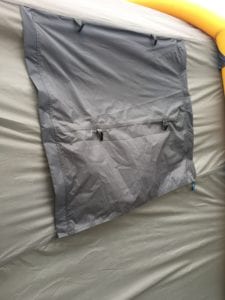
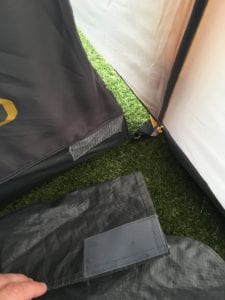 It connects to the flysheet and the bedrooms by Velcro, so it is easy to roll it up in case you need a wet area for your mucky gear.
It connects to the flysheet and the bedrooms by Velcro, so it is easy to roll it up in case you need a wet area for your mucky gear.
You have one door with a mesh panel and a roll-up rain-cover, and one half-mesh-half-PVC window opposite the entrance. The flysheet over the window can be rolled up in two sections (half or full), leaving you more room to regulate the air-flow across the tent.
The seams are taped.
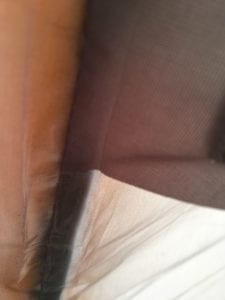

Size
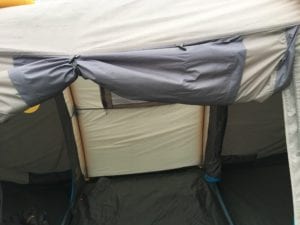
Mind your head
The external size of the whole tent is 250cm x 595. You have a 190cms high ceiling measured at the middle of the tent, that becomes gradually less as you go into the bedrooms. It seems a bit low – especially if you compare it to other tents that have more than 2.1 metres high ceiling – but once inside, it doesn’t feel uncomfortable with my 186cms. Although I must bend a little bit as I enter the tent, but in general, it does not feel too low.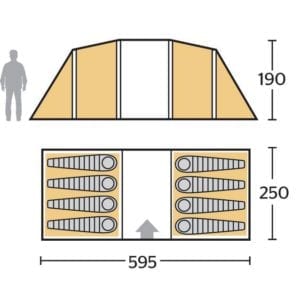
Stepping inside, you find the two 240 x 210 cm bedrooms on the sides. They enclose a living area where you can store your mucky gear and backpacks. You may be able to put some chairs and a table in there too, however don’t expect a miracle: the living space is only 4 sqm.
 Bedrooms
Bedrooms
There are 2 bedrooms facing each other. Both can be removed if you need more living area (see pics). They don’t have mesh panels, but they roll-up fully and tuck away to the side, or can be opened to the upper third only for better air-flow. Both are ‘darkened’, meaning they are made of darker material to provide a better night’s sleep. The breathable polyester (same specs as the flysheet, 68D 185T) feels soft and comfortable.
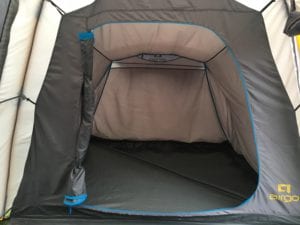
There are small windows in the top corner too, to let some air in.
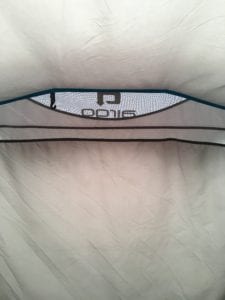
Small window, with a small hanging hook. You’ll need it for the bug zapper
As for storage, you have a couple of pockets in each bedroom, and 1 hanging hook.
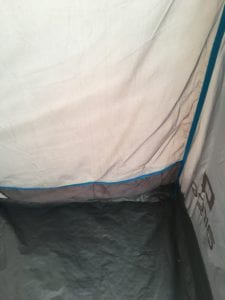
A couple of storage mesh pockets

Light-colour materials…the camera helped a bit though
Size-wise, you have 240cms for four people. It can be enough, and you can put two compact size inflatable mattresses in each room. Interestingly, the Berghaus Air 6 (GoOutdoors) has 2 bedrooms of a similar size, 230cm x 210cm, yet that is sold as a 6-person tent…
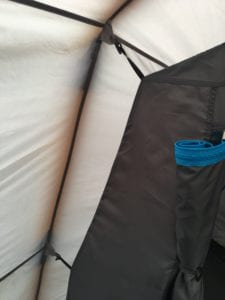
Just unhook the bedrooms and voila…
The Bad Stuff
So far so good, right? I keep thinking why anyone would buy anything other than the Airgo Air Genus 800, it is cheaper than most 4-person air tents…
Now the bad stuff…not that bad but it may help explain why I think that the Air Genus 800 (and 400) are not for hard-core campers. It comes at an entry level price so must be treated as an entry-level product…
The Flysheet
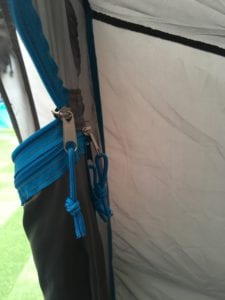
Flimsy zippers
I said it is lightweight and water-proof 68 Denier 185T polyester flysheet, but that’s only one side of the story. It is lightweight because it is thin – 68D (Denier) – while most (traditional and inflatable) tents have a minimum of 70D or 75D, or up to even thicker, 150D flysheet (Kampa, for example).
The ‘T’ refers to the thread count (T), which is the number of threads used horizontally and vertically per square inch of fabric … 210T means a total of 210 threads. A higher thread count represents a greater density and tighter weave in the fabric. For this reason you will often find lower Denier fabrics (with a ‘thinner’ thread) have a higher thread count. Not in this case, 185T is a very low thread number.
Related post: Tent materials, fabrics, specifications and all the acronyms. FAQ.
Why this is an issue? Look at this. This is not ‘ripstop’ that’s for sure.

Ventilation
While polyester is lightweight, quick to dry out and generally more resistant to mildew and needs less maintenance, it is also not a very good insulator.
This means that polyester tents can get very hot when it is warm, and chilly when it gets cold. With the limited number of air vents, and the limited option to create a drought across the tent, the Air Genus would likely become baking hot in the summer, and rather cold in cooler seasons.
Groundsheet
While the groundsheet can be rolled up (because it is not sewn in), and is waterproof, it is not particularly thick. 140gsm is the thickness of a standard garden tarp, but fair enough, it helps keeping the weight low and it takes up less space than a thicker one.
Uneven, rocky ground, or general use over time will likely weaken and damage it at some point. Also, it only covers the living area, nothing else. The bathtub style bedrooms have a bottom made of the same material as the groundsheet, but they sit on plain ground.
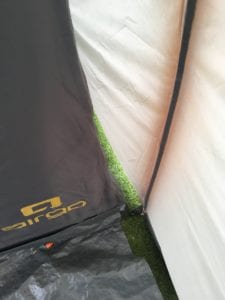
So I suspect it can become quite cold, they hardly provide any thermal insulation.
Secondly, water can enter underneath them easily. Sleeping in a puddle is not very high on my bucket-list.
Thirdly, don’t expect to be able to keep your dog inside, they will easily find their way out as soon as they smell the BBQ from the tent next door.
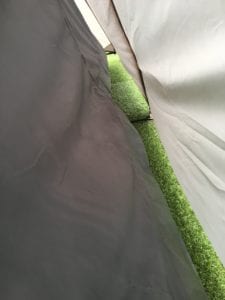
Lastly, insects will easily find their way in, so it is essential to get a decent bug zapper, insect repellent lamp or other means of keeping the bugs out.
On the other hand, it can help reduce condensation on the inner side of the flysheet…
So, my advice is to get the bespoke footprint. OH WAIT…There is not one!!…
Yes, go search it online and you won’t find one stocked by GoOutdoors! I find it really strange, I really do hope they will stock it later…
One more thing…
This only me moaning all the time. I guess one can’t have everything, especially not for this price, but I did not mind if the living area was slightly bigger. In my naïve world I presumed that if someone designed an 8-men tent, the living area would be slightly bigger. I just think that it is simply not the greatest space to spend a lot of time in, but it does the job…As opposed to most of other tents, the living area is not for the campers to spend a lot of time in. You most likely will use it as a storage and a shelter if it starts raining.
I must admit, that it is a different, more practical but nonetheless valid approach. I am sure some of you will appreciate this practicality, and would not mind spending their time outside the tent anyways.

Final Thoughts…
Now I hope I have not been too harsh on the Airgo Air Genus 800. The point of this review was to give you an idea of what you can expect. I still think that for £299, the Air Genus 800 is very good value for money. So, if you are looking for an 8-person inflatable tent (or a 6-person, or a 4-person, or whatever) and you only have £300, it is money very-very well spent. (for more budget options check out my round-up post: Best Air Tents in 2020)
Having said that, you’d probably better budget for some extra accessories to make your stay much more comfortable and memorable for the right reasons. These must-have accessories are for example, but not limited to:
- A footprint (any tarpaulin, minimum 190 gsm thickness)
- Compact size air beds or (elevated) camping beds (like this or these)
- A mosquito / bug killer (like this for example)
- Good sleeping bags
- Duck tape (silver)
- Proper metal stakes to increase stability in windy weather
I must admit, there is not much that could compete with the value for THIS price. The Eurohike Air 600 costs around the same price (review here), but it has a different layout. I can work for 6 (or less people), so if you have never intended to use the Air Genus 800 as an 8-berth tent, than the Eurohike Air 600 may be an alternative.
- The Eurohike Genus 800 and similar vis-a-vis 8 person tents.
- The best air tents in 2021, a round-up of every size, every budget from £150 to £2000
- Eurohike Genus 400 versus other, entry level 4 person small family tents in this post.
- If you are looking for spacious air tents for 4-5 persons, I have selected 5 that I can recommend.
- You can also check out the Eurohike Air 400. You find my detailed review here.
- If you need an inflatable tent for 6 or more, I urge you to check out this post before you make your mind up.
So to answer the most important questions: would I recommend the Airgo Air Genus 800? If it is not clear yet, my answer is a definite YES, as long as you can get it for £300 and keep its limitations in mind!
You can buy it online (or in any GoOutdoors store), or from Blacks, Millets and Ultimate Outdoors for £324.
Airgo Air Genus 800 vs Eurohike Genus 800 key differences
While the two tents are almost identical, there a few notable differencies:
- The Eurohike airbeams are in blue tubes, rather than yellow ones
- The Eurohike is slightly lighter 12.8 kg v. 13.6 kg
- The Eurohike Genus 800 has 3000mm HH rating compared to the 4000mm HH of the Air Genus 800
I should also add, that there’s very little information on the fabric and flysheet used by the Eurohike Genus 800. While Airgo openly admitted the low-end fabrics they used to keep the Air Genus 800 cheap, I can only assume that the Eurohike Genus 800 is not much of an improvement in this regard.
Please leave a comment if you have any questions, or would like to share your views on the Airgo Air Genus 800!


 Bedrooms
Bedrooms
Thankyou for your opinion.We have ordered 3 at £199 each.Bargain until i realised no fitted groundsheet.After reading your views its made me realise i may be better off without one due to ventilation etc.The plus points outweigh the minus.
Hi, I don’t know if you can help at all. Thank you for the review!
Do you know of any other footprint that would be suitable? I am in the UK.
Thank you in advance.
Hi, I could not find one, and it’s been an issue ever since the air genus 800 has come out.
We purchased ours last year and I got a tarp on amazon with eyelets that was twice the size I needed and also purchased an eyelet kit. Cost less than £30 and an hour of my timed we now have a perfectly sized footprint and a spare!
We purchased ours last year and I got a tarp on amazon with eyelets that was twice the size I needed and also purchased a grommet kit. Cost less than £30 and an hour of my time, and we now have a perfectly sized footprint and a spare!
We bought a Airgo 800 2020. After reading the above I was sceptical at using it for a 7 night holiday ,well putting it up went well and quick 1st night was great nights sleep sadly the forecast for the second night was not good with winds in the 40 mph . The tent held well with wind but come the 3rd and fourth night the wind increased to 54mph a bit frightening as it bent in and we were more worried about the tent being ruined , miraculously the guide ropes didn’t slack at all .Then on the fourth night we had the torrential thunder storm but not one bit of water came in at all , sadly as the weather was going to continue we packed the tent up with a heavy heart . We are going back this year but this time have opted for a hedged pitch as we were in an open field last year . All in all our tent served us well
Great to hear, thanks for sharing!
I live in the UK and have just bought an Eurohike Genus 800 for £269 from Millets online then found when looking for ground sheet the same tent for £249 from Go I am now looking for two ground sheets for 2.5 mtr x 3 mtrs and overlapping under living area I always use a carpet or exercise tiles for the floor covering to save the ground sheets from damage from Fridge cooker and freezer and a self inflating double bed with continental quilt and a air con unit to keep the heat down in summer. I find this is fine for summers on the med.
Hi Neil,
Thanks for your comment, great tips for the footprint and protecting the goundsheet.
I also noticed, that since Airgo has become Eurohike and you can buy them in Blacks / Millets / Ultimate Outdoors, as well as, in GoOutdoors, the latter is often cheaper (or more frequently has special events / sales).
hi i have got a eurohike genus 800 airtent and wondered if anybody has used velco to stick the ground sheet to the sides to stop alot of air coming in as it gets cold in the night because to tent has not got a built in ground sheet so i am thinking of doing this next time i go camping or is there anywhere i could take my tent to have one sewn inn to stop this problem .
Hi,
I don’t know of any place specifically that would sew velcro on. You could try it with a double sided tape for fabrics (although normal ones might work well too). This is what I’m thinking about: https://amzn.to/3wWl52J
I would add, although it’s a family size tent, you do need a shelter to add cooking stuff, as you can’t cook inside the tent! Which is more costly and obviously increases pitch prices.
Apart from that we have found it very suitable for my disabled daughter and her 2 girls as she can get inside easily .